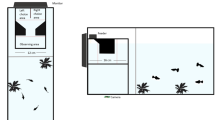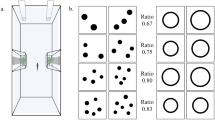Abstract
In recent years, the use of operant conditioning procedures has shown that species as diverse as chimpanzees, honeybees, and mosquitofish can be trained to discriminate between sets containing different numbers of objects. However, to succeed in this task, subjects can use two different strategies: either select the array containing a specific number of items (an absolute numerosity rule), or select the set containing the larger (or smaller) quantity of items (a relative numerosity rule). In the latter case, subjects need not only be able to judge whether two numerosities are equal or different but also be able to order numerosities. Here, in two experiments, we address whether fish can perform both kinds of judgment by training them with specific numerosities and testing their generalization to new numerosity contrasts. In Experiment 1, subjects were initially trained to select between visual arrays of 6 and 12 shapes, and were then tested with a contrast pairing the previously trained numerosity (either 6 or 12) with a novel numerosity (respectively, 3 or 24). Spontaneously, subjects selected the novel numerosity, in accordance with a relative numerosity rule. The second experiment tested whether guppies can also learn to select one specific number against all others, if appropriately trained. Fish trained to select an array of 4 shapes against several alternatives (4 vs. 1, 4 vs. 2, 4 vs. 8, 4 vs. 10) learned to recognize the number 4 against all alternatives and proved able to generalize their discrimination to novel, more difficult contrasts (4 vs. 3 and 4 vs. 6 items). In summary, although guppies preferentially opt for relative comparisons, they can flexibly learn either relative or absolute decision criteria on numerosity stimuli, depending on the context.





Similar content being viewed by others
References
Agrillo C, Bisazza A (2014) Spontaneous versus trained numerical abilities. A comparison between the two main tools to study numerical competence in non-human animals. J Neurosci Methods 234:82–91
Agrillo C, Dadda M (2007) Discrimination of the larger shoal in the poeciliid fish Girardinus falcatus. Ethol Ecol Evol 19(2):45–157
Agrillo C, Dadda M, Serena G, Bisazza A (2009) Use of number by fish. PLoS ONE 4(3):e4786
Agrillo C, Piffer L, Bisazza A (2010) Large number discrimination by fish. PLoS ONE 5(12):e15232
Agrillo C, Piffer L, Bisazza A (2011) Number versus continuous quantity in numerosity judgments by fish. Cognition 119:281–287
Agrillo C, Piffer L, Bisazza A, Butterworth B (2012a) Evidence for two numerical systems that are similar in humans and guppies. PLoS ONE 7(2):e31923
Agrillo C, Miletto Petrazzini ME, Piffer L, Dadda M, Bisazza A (2012b) A new training procedure for studying discrimination learning in fishes. Behav Brain Res 230:343–348
Agrillo C, Miletto Petrazzini ME, Tagliapietra C, Bisazza A (2012c) Inter-specific differences in numerical abilities among teleost fish. Front Psychol 3:483
Agrillo C, Miletto Petrazzini ME, Bisazza A (2014) Numerical acuity of fish is improved in the presence of moving targets, but only in the subitizing range. Anim Cogn 17:307–316
Beran MJ (2006) Quantity perception by adult humans (Homo sapiens), chimpanzees (Pan troglodytes), and rhesus macaques (Macaca mulatta) as a function of stimulus organization. Int J Comp Psychol 19:386–397
Bisazza A (2010) Cognition. In: Evans J, Pilastro A, Schlupp I (eds) Ecology and evolution of poeciliid fishes. Chicago University Press, Chicago, pp 165–173
Bisazza A, Agrillo C, Lucon-Xiccato T (2014) Extensive training extends numerical abilities of guppies. Anim Cogn 17(6):1413–1419
Bodmer RE (1990) Fruit patch size and frugivory in the lowland tapir (Tapirus terrestris). J Zool 222(1):121–128
Brannon EM, Terrace HS (1998) Ordering of the numerosities 1 to 9 by monkeys. Science 282:746–749
Buckingham JN, Wong BBM, Rosenthal GG (2007) Shoaling decision in female swordtails: how do fish gauge group size? Behaviour 144:1333–1346
Cantlon JF, Brannon EM (2007) How much does number matter to a monkey (Macaca mulatta)? J Exp Psychol Anim Behav Proc 33:32–41
Cheng K, Spetch ML, Johnston M (1997) Spatial peak shift and generalization in pigeons. J Exp Psychol Anim Behav Proc 23(4):469–481
Cresswell W (1994) Flocking is an effective anti-predation strategy in redshanks, Tringa totanus. Anim Behav 47(2):433–442
Davis H (1984) Discrimination of the number three by a raccoon (Procyon lotor). Anim Learn Behav 12:409–413
Dougherty DM, Lewis P (1991) Stimulus generalization, discrimination learning, and peak shift in horses. J Exp Anal Behav 56(1):97–104
Feigenson L, Carey S, Spelke ES (2002) Infants discrimination of number vs. continuous extent. Cogn Psychol 44:33–66
Foster WA, Treherne JE (1981) Evidence for the dilution effect and the selfish herd from fish predation on a marine insect. Nature 293:466–467
Gebuis T, Reynvoet B (2012) The role of visual information in numerosity estimation. PLoS ONE 7(5):e37426
Gierszewski S, Bleckmann H, Schluessel V (2013) Cognitive abilities in Malawi cichlids (Pseudotropheus sp.): matching-to-sample and image/mirror-image discriminations. PLoS ONE 8(2):e57363
Gómez-Laplaza LM, Gerlai R (2012) Activity counts: the effect of swimming activity on quantity discrimination in fish. Front Psychol 3:484
Gómez-Laplaza LM, Gerlai R (2013a) Quantification abilities in angelfish (Pterophyllum scalare): the influence of continuous variables. Anim Cogn 16:373–383
Gómez-Laplaza LM, Gerlai R (2013b) The role of body surface area in quantity discrimination in angelfish (Pterophyllum scalare). PLoS ONE 8(12):e83880
Gross HJ, Pahl M, Si A, Zhu H, Tautz J et al (2009) Number-based visual generalisation in the honeybee. PLoS ONE 4(1):e4263
Hanggi EB (2003) Discrimination learning based on relative size concepts in horses (Equus caballus). Appl Anim Behav Sci 83:201–213
Hanson HM (1959) Effects of discrimination training on stimulus generalization. J Exp Psychol 58:321–334
Lucon-Xiccato T, Bisazza A (2014) Discrimination reversal learning reveals greater female behavioural flexibility in guppies. Biol Lett 10(6):20140206
Miletto Petrazzini ME (2014) Trained quantity abilities in horses (Equus caballus): a preliminary investigation. Behav Sci 4:213–225
Miletto Petrazzini ME, Agrillo C, Piffer L, Dadda M, Bisazza A (2012) Development and application of a new method to investigate cognition in newborn guppies. Behav Brain Res 233:443–449
Nelson XJ, Jackson RR (2012) The role of numerical competence in a specialized predatory strategy of an araneophagic spider. Anim Cogn 15:699–710
Olton DS, Samuelson R (1974) Decision making in the rat: response-choice and response-time measures of discrimination reversal learning. J Comp Physiol Psychol 87(6):1134–1147
Pepperberg IM (2006) Grey parrot numerical competence: a review. Anim Cogn 9:377–391
Pepperberg IM, Brezinsky MV (1991) Acquisition of a relative class concept by an African gray parrot (Psittacus erithacus): discriminations based on relative size. J Comp Psychol 105:286–294
Perdue BM, Talbot CF, Stone A, Beran MJ (2012) Putting the elephant back in the herd: elephant relative quantity judgments match those of other species. Anim Cogn 15:955–961
Perry CJ, Barron AB, Cheng K (2013) Invertebrate learning and cognition: relating phenomena to neural substrate. Wiley Interdiscip Rev Cogn Sci 4(5):561–582
Purtle RB (1973) Peak shift: a review. Psychol Bull 80:408–421
Royama T (1970) Factors governing the hunting behaviour and selection of food by the great tit (Parus major L.). J Anim Ecol 39(3):619–668
Rugani R, Regolin L, Vallortigara G (2008) Discrimination of small numerosities in young chicks. J Exp Psychol Anim Behav Proc 34:388–399
Siebeck UE, Litherland L, Wallis GM (2009) Shape learning and discrimination in reef fish. J Exp Biol 212(13):2113–2119
Sokal RR, Rohlf FJ (1995) Biometry. Freeman and Company, New York
Sovrano VA, Bisazza A (2008) Recognition of partly occluded objects by fish. Anim Cogn 11:161–166
Thomas RK (1980) Evolution of intelligence: an approach to its assessment. Brain Behav Evol 17:454–472
Vonk J, Beran MJ (2012) Bears “count” too: quantity estimation and comparison in black bears (Ursus americanus). Anim Behav 84:231–238
West R, Young RJ (2002) Do domestic dogs show any evidence of being able to count? Anim Cogn 5:183–186
Acknowledgments
The authors would like to thank Laura Piffer for her help in testing the subjects and two anonymous reviewers for their useful comments. The study complies with all laws of the country (Italy) in which it was performed and was supported by “FIRB grant 2013” (prot.: RBFR13KHFS) to C. Agrillo from Ministero dell’Istruzione, Università e Ricerca (MIUR, Italy).
Conflict of interest
The authors declare that they have no conflict of interest.
Author information
Authors and Affiliations
Corresponding author
Rights and permissions
About this article
Cite this article
Miletto Petrazzini, M.E., Agrillo, C., Izard, V. et al. Relative versus absolute numerical representation in fish: Can guppies represent “fourness”?. Anim Cogn 18, 1007–1017 (2015). https://doi.org/10.1007/s10071-015-0868-y
Received:
Revised:
Accepted:
Published:
Issue Date:
DOI: https://doi.org/10.1007/s10071-015-0868-y




